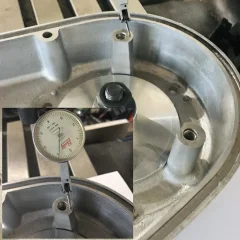- Joined
- Dec 28, 2008
- Messages
- 2,035
I have read just about all the posts dealing with getting a uniform clearance between stator and rotor. The 2 most common seem to be 1) machine the rotor. 2) exploit the wiggle room, if available, between the engine and inner primary. 3) enlarge the holes of the stator that the stand-off studs fit through. 4) somewhere in this forum someone suggested smacking the stator with the goal of bending the stand-offs. ( I read that post with a cringe)
The clearance on the Norton I am assembling has about .012 to .013 clearance between the 6 and 12 O'clock position, but tightens up gradually to unacceptable at the 3 O'clock position; just where you want the most clearance. I have rotated the stator using all positions and get the same issue. While mounting the inner primary, knowing the issues associated with stator/rotor, I use what little wiggle room I had to move the inner case as far rearward could. (yes center fixing stud was measured and shimmed properly)
The stator and rotor are both Wassell branded. I have several rotors including OE Lucas, I measured the spares (junk?) against the new Wassell and see variation in the low tenths; insignificant.
I have yet to remove the stand-offs and check them for signs of being bent; I have plenty of others I can try.
My question: If the stand-offs check out I'm thinking that opening the inner part of the stator with an abrasive wheel (Dremel type, but turned by cordless drill). I fear that I may ruin the stator. Has anyone tried something like this?
Best.
The clearance on the Norton I am assembling has about .012 to .013 clearance between the 6 and 12 O'clock position, but tightens up gradually to unacceptable at the 3 O'clock position; just where you want the most clearance. I have rotated the stator using all positions and get the same issue. While mounting the inner primary, knowing the issues associated with stator/rotor, I use what little wiggle room I had to move the inner case as far rearward could. (yes center fixing stud was measured and shimmed properly)
The stator and rotor are both Wassell branded. I have several rotors including OE Lucas, I measured the spares (junk?) against the new Wassell and see variation in the low tenths; insignificant.
I have yet to remove the stand-offs and check them for signs of being bent; I have plenty of others I can try.
My question: If the stand-offs check out I'm thinking that opening the inner part of the stator with an abrasive wheel (Dremel type, but turned by cordless drill). I fear that I may ruin the stator. Has anyone tried something like this?
Best.




